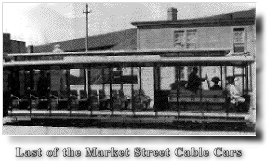|
||||
|
||||
|
|||||||||||||||||||
 Street Railways are most businesslike and yet the history of Market
Street Railway for one is filled with romance, a story of remarkable
evolution from little beginnings up to a great system which leading railway
engineers have valued in excess of sixty millions of dollars, "reproduction
cost new" and upon which our own City Engineer O'Shaughnessy placed a
valuation of $40,000,000 as a fair price for the City to pay for its
purchase. Street Railways are most businesslike and yet the history of Market
Street Railway for one is filled with romance, a story of remarkable
evolution from little beginnings up to a great system which leading railway
engineers have valued in excess of sixty millions of dollars, "reproduction
cost new" and upon which our own City Engineer O'Shaughnessy placed a
valuation of $40,000,000 as a fair price for the City to pay for its
purchase.
Its history is interwoven with the romance of San Francisco. Its present is a splendid reality. Its future arouses interest and stirs the imagination. These Railways have forty years yet to live, a longer time than its consolidated system has been in existence, since the longest franchise will be alive in 1965. Forty years is a long time, nearly half a century. What changes, improvements, developments, enhancements in value will come within that time?
In 1860 the "Pioche Railroad" was started by the Market Street Railway Company, which graded Market Street. This road at first was operated by steam dummies, later by means of horses. In 1870 the first "Balloon" car was built. This car carried its own turn table and was drawn by mules. When the end of the line was reached the driver lifted a pin running from the body of the car to the trucks, turned the mules in a half circle to where the rear of the car had been, and stuck the pin back in, ready for the return trip.
In 1893, twenty years later, an electric line commenced operating, and gradually replaced the cable cars. A comparison of the past and present of San Francisco's street railways cannot but cause better appreciation of the city's street car transportation facilities. The standard little old horse car was about twenty-five feet long an averaged seats for fourteen passengers, with room for five to stand. "Bob-tailed" cars were run also.
The new Blue and Gold Car just
inaugurated by the Market Street Railway Company is 47 feet long, over
bumpers, has a seating capacity for 50 passengers, and is "Made in San
Francisco by San Franciscans for San Franciscans."
In early days, in spite of the inconveniences of street railways travel and the very short distance that a passenger could ride, the fare was twenty-five cents. Now, not-withstanding the tremendous advance in all costs, 260,000,000 passengers, including those using transfers, rode on the Market Street Railway Company last year [1924] for a five cent fare, which also entitled them to transfers good all over the system, on cars equipped with modern conveniences, a ride exceeding 20 miles if a person desired to use all transfer privileges. In other words, for these new and modern conveniences, for liberal transfer privileges and for a long ride, a passenger today pays only one-fifth of the charge of early days.
The Company is mindful, too, of its men and any story concerning it would be incomplete if a special mention be not made of their responsive faithfulness and loyalty. Many hundreds of its stockholders are residents of San Francisco. As to the future: The length of time of the franchises under which the Market Street Railway will continue to operate is not appreciated generally. Very important franchises extend beyond 1940, others covering no inconsiderable portion of the Company's mileage extend to varying dates from 1952 to 1965, whereas those which do not extend beyond 1930 cover less than twenty percent of its total mileage. Market Street Railway Company has forty years to live, four decades. Within that number of years in the past, many great changes and well-neigh incredible developments have taken place, and within that space of time in the future the city's population may well quadruple.
The Company is contemplating placing in service cable cars on which the
cable grip and brakes are operated by air, a recent invention to displace
the present unwieldy manually operated grip, give more space and convenience
for passengers, and materially lighten the work of gripmen. This is the
first substantial improvement in method of operating cable cars, since their
inauguration. And so goes the tale, which might be carried on indefinitely,
always with items of interest.
For more on San Francisco streetcars, see History by Subject.
|